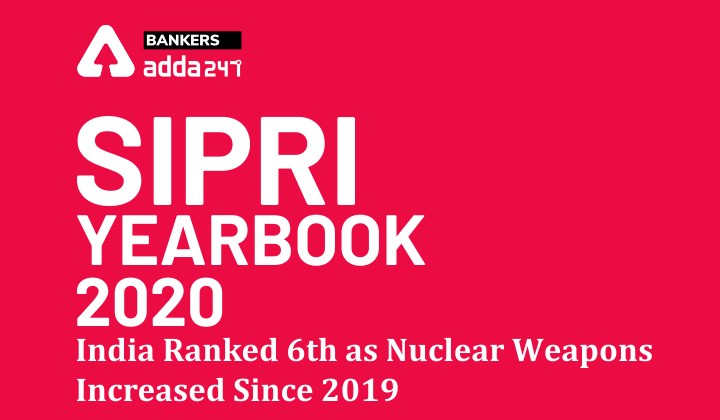Table of Contents
The Stockholm International Peace Research Institute (SIPRI) has launched SIPRI Yearbook 2020. This Yearbook assesses the current state of armaments, disarmament and international security. The 51st edition of the Yearbook reveals an unbroken deterioration within the conditions for international stability.
In accordance with the “SIPRI Yearbook 2020-Armaments, Disarmament and International Security” from 2019 there’s a rise within the nuclear weapons stockpile of India and China. However India’s overall possession of nuclear weapons is a smaller amount than half Beijing’s and also slightly less than what Pakistan possesses.
Also Check
- UNICEF Publishes “LOST AT HOME” Report: Read to Know More
- Atal Pension Yojana (APY) completes 5 years of implementation
- Union HRD Minister releases “India Rankings 2020” for Higher Educational Institutions
- Nature Index 2020: India ranked 12th in science research
Nuclear warhead reductions continue despite growing tensions
The nine nuclear-armed states: US, Russia, UK, France, China, India, Pakistan, Israel and therefore the Democratic People’s Republic of Korea (North Korea)—together possessed an estimated 13 400 nuclear weapons at the start of 2020. This marked a decrease from the 13 865 nuclear weapons that SIPRI estimated these states possessed at the start of 2019 (see table below). Around 3720 of the nuclear weapons are currently deployed with operational forces and nearly 1800 of those are kept during a state of high operational alert.
Also Check
- Uttarakhand releases report on conservation of endemic, threatened floras
- International Day for the Fight against Illegal, Unreported and Unregulated Fishing: 5 June
- World Brain Tumour Day 2020 on 8 June
- Endangered Species Day 2020
- FSSAI releases State food safety index for 2019-20
Next-generation nuclear weapon systems are in development
Russia and the USA have extensive and expensive programmes underway to exchange and modernise their nuclear warheads, missile and aircraft delivery systems, and weapon of mass destruction production facilities. Both countries have also given new or expanded roles to nuclear weapons in their military plans and doctrines, which marks a big reversal of the post-cold war trend towards the gradual marginalization of nuclear weapons.
Also Check
- MOHUA announced results of Star rating of garbage-free cities
- HIV Vaccine Awareness Day
- World Thalassaemia Day 2020: Need to Know Types, Symptoms, History
- European Union announces 750 billion- euro COVID-19 recovery fund
Low levels of transparency in reporting on nuclear weapon capabilities
The availability of reliable information on the status of the nuclear arsenals and capabilities of the nuclear-armed states varies considerably. The governments of India and Pakistan make statements about a number of their missile tests but provide little information about the status or size of their arsenals. North Korea has acknowledged conducting weapon of mass destruction and missile tests but provides no information about its weapon of mass destruction capabilities.
Israel features a long-standing policy of not commenting on its nuclear arsenal. The UK and France have also declared some information. Russia doesn’t make publicly available an in depth breakdown of its forces counted under New START, albeit it shares this information with the USA.
You may also like to read:
- Current Affairs one-liners
- Current Affairs & Daily GK Updates 2020
- Download GA Power Capsule for Bank/Insurance Exams
Following table shows the number of warheads of top rankers (as of January 2020):
| Rank | Country | Nuclear Warheads |
|---|---|---|
| 1 | USA | 5 800 |
| 2 | Russia | 6 375 |
| 3 | United kingdom | 215 |
| 4 | France | 290 |
| 5 | China | 320 |
| 6 | India | 150 |
| 7 | Pakistan | 160 |
| 8 | Israel | 90 |
| 9 | North Korea | (30–40) |
Also Check
Click Here to Register for Bank Exams 2020 Preparation Material
Visit Achieversadda.com and participate in discussions with other aspirants and achievers. Get answers to your queries and connect with others on Achieversadda.com



 Adda247 Launched the Coaching with Degre...
Adda247 Launched the Coaching with Degre...
 Financial Regulators In India
Financial Regulators In India
 What is the Monthly Salary of Bank PO?
What is the Monthly Salary of Bank PO?




